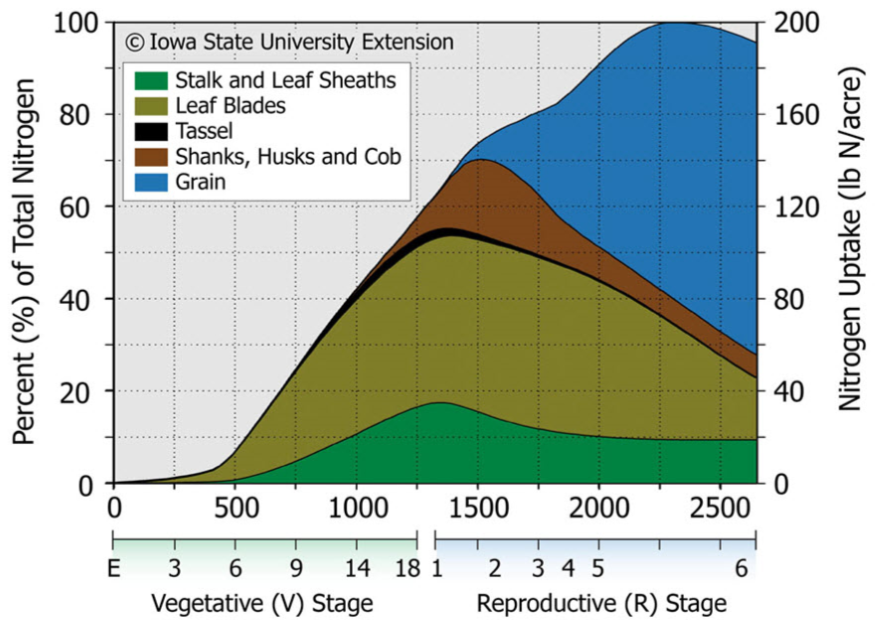Split Nitrogen Applications
Applying nutrients at the Right Time and Right Rate means developing a strategy to distribute nutrients to your growing plant multiple times throughout the growing season. How to determine the needs of the crop mid-season can be challenging, although several tests and technologies are available to make splitting your nitrogen a truly effective way to efficiently use nutrients to improve crop yield and reduce the risk of environmental loss.
What are the benefits?
 By dividing the application of nitrogen between planting and more mature growth stages, more of the nitrogen applied will have a chance to be taken up by the crop and not lost to denitrification, runoff, or leaching.
By dividing the application of nitrogen between planting and more mature growth stages, more of the nitrogen applied will have a chance to be taken up by the crop and not lost to denitrification, runoff, or leaching.- By most accounts, targeted application of nitrogen when the crop, particularly corn, can immediately utilize it gives the growing plant the best chance to reach its potential yield. By splitting nitrogen application, farmers can most efficiently and effectively ensure that this valuable input ends up in the cash crop and not leaving the field.
- It allows you to adapt your in-season management. If you apply much of your nitrogen at the beginning of the season, you have less flexibility to respond to more or less favorable early-season growing conditions that have impacted yield potential.
Application Timing & Corn Nitrogen Needs
The majority of nitrogen taken up by a growing corn plant takes place at the V6 to V8 growth stages. At this stage, the plant is greatly investing in leaf blade development, and those leaves will be the engine that drives the plant to reach its full yield potential.
Nitrogen begins to reallocate to the reproductive parts of the plant as the corn ears and grain begin to develop. By harvest time, roughly 70% of the nitrogen in the plant is concentrated in ear, particularly the corn grains.
Applying nitrogen at the right time is crucial for corn development, but it also limits the potential impact of lost nitrogen on the environment.
Splitting Nitrogen: Decision Tools
Pre-sidedress Nitrate Test
The Pre-sidedress Nitrate Test (PSNT) is an in-season soil nitrate test that can be used to determine if additional fertilizer nitrogen (N) is needed for corn. This test should be conducted on soil samples taken just prior to sidedressing (just before the period of major N demand by corn). The PSNT is designed to: (1) estimate the soil’s nitrate supplying potential, and (2) decide if there is enough N to meet crop needs.
The test can be performed for fields with a history of manure and/or sod incorporation.
Plant Tissue Test
Measuring the chlorophyll concentration based on leaf color can be used to estimate nitrogen deficiencies of the growing corn crop. This test is also a pre-sidedress test, run just before the major nitrogen demand by the crop.
It is also being utilized very effectively under irrigation where fertilizer can be adjusted several times during irrigation events throughout the growing season based on plant tissue readings.
The color of the leaves is read directly on the plant in the field with a handheld meter. Thus, no samples need to be collected and analyzed and the results are available immediately. However, it is necessary to have a high-N fertilized check area in the field to calibrate the meter.
Is your system calibrated?
Planning on establishing a nitrogen-rich check strip in your field allows you to use several tools to measure nitrogen needs in your growing crop. The check strip is used as a reference point for the rest of the field whether you are using PSNT, plant tissue testing, or satellite imagery to make your nitrogen decisions.
Resources
- Cornell University’s Nutrient Management Spear Program
- Factsheet: Nitrogen Management for Corn in Delaware: The Pre-sidedress Nitrate Test (University of Delaware Extension)
- Factsheet: Chlorophyll Meter Test (PennState Extension)
- Search for additional resources here:
Related Practices
Nitrogen Modeling, Variable-Rate N Application, Cover Crops


